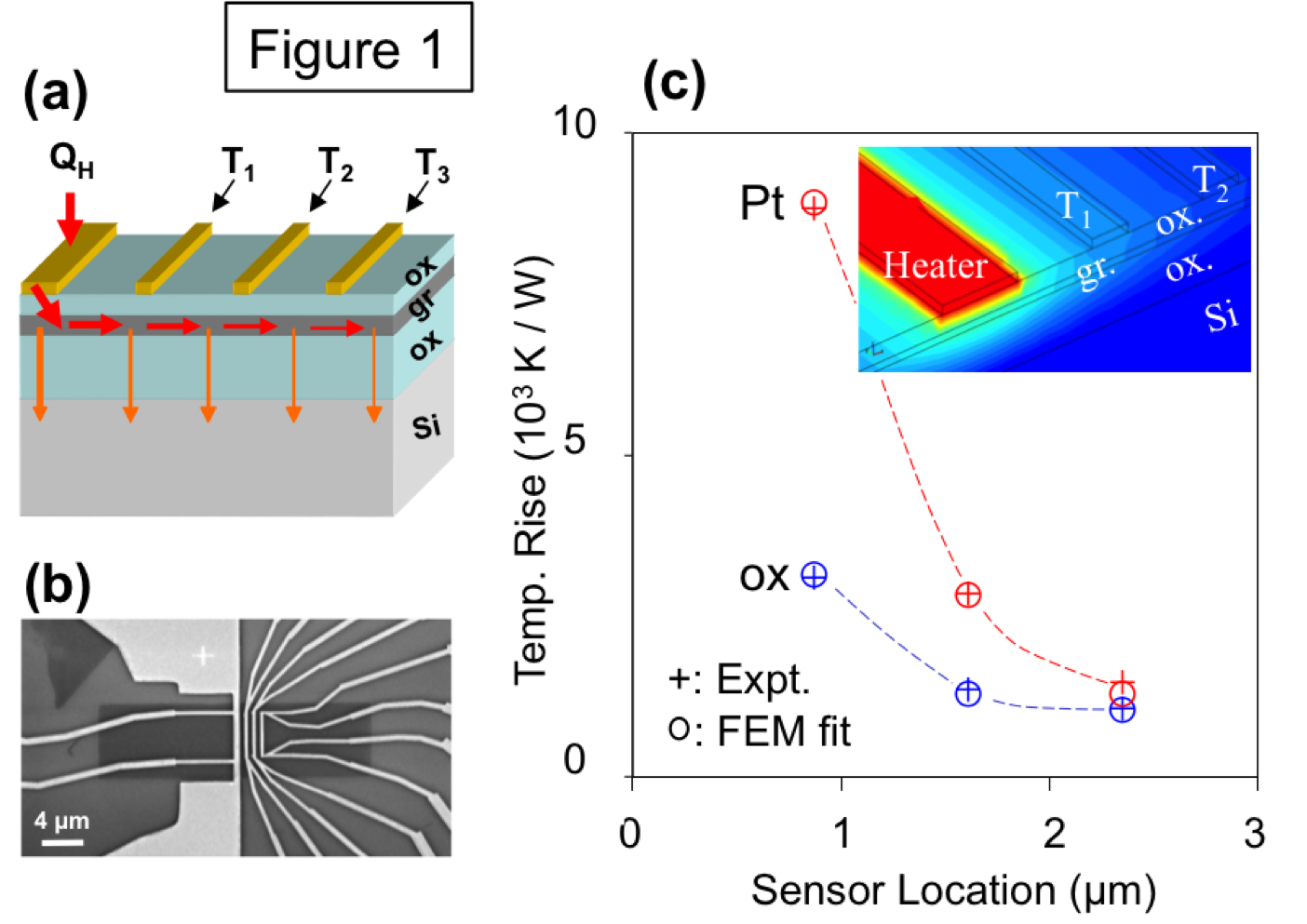 |
 |
 |
Overview
Our research spans a range of fundamental topics in thermal sciences and energy conversion, using both modeling and experiments. Listed below are a range of current and past projects we have worked on, roughly beginning with the most recent.
Research:
Scanning Electron Microscope (SEM) Thermometry

High-resolution thermal imaging is important for the characterization of many modern day solid state devices, including transistors and optoelectronic devices. Such imaging is also helpful for fundamental understanding of microscale heat transfer where classical continuum equations break down, as in nanostructured materials such as thin films, nanowires, and nanocomposites. One effort in nanothermometry is to utilize a scanning electron microscope (SEM) as a tool to map temperature at the nanoscale. SEM has spatial resolution in the nanometer range because it uses a high energy electron beam as the probe. There are several signals from the primary electron beam interacting with the sample. Some of these signals contain thermal information and can be used to extract the temperature of the sample. If successful, this technique will have significant scientific as well as engineering impact due to the wide availability of SEMs in research labs worldwide.
Publications: Khan et al.
Transmission Electron Microscope (TEM) Thermometry

We are developing temperature measurement techniques in the scanning transmission electron microscope (STEM). STEM offers the potential for ultra-high spatial resolution temperature mapping, since the electron beam is focused down to < 5 nm. Using the facilities at the National Center for Electron Microscopy, we have measured temperature-dependent thermal diffuse scattering (TDS) in diffraction patterns and annular dark field signals. We will use these TDS signals to map temperature at the nanoscale in the STEM.
Publications: Wehmeyer et al.
Thermal Diodes, Regulators, and Switches

We research new thermal devices with functionalities that exceed the capabilities of traditional thermal resistors and capacitors. As surveyed in our review article [1], thermal diodes can rectify heat currents, thermal regulators can maintain a desired temperature, and thermal switches actively control the heat transfer. To demonstrate a possible application of these thermal devices, we showed that using thermal diodes to rectify an oscillating temperature profile improves the efficiency of thermoelectric waste heat scavenging [2].
Publications: Wehmeyer et al.; Chen et al.; Dames; Miller et al.
Thermal Diode Bridge

Maximally utilizing the innately periodic availability of sunlight as a constant source of energy is a long-standing challenge. Inspired by the idea of the electrical diode bridge, used to convert AC signals into DC signals, we have developed a thermal analogue to address this problem. As shown in figure 1a, the thermal diode bridge harvests solar energy during the day to provide heat to the hot mass (thermal storage), and then releases heat to the night sky to provide cooling for the cold mass. This converts the time-periodic temperature input into two relatively constant temperatures, T1 and T2, across the heat engine. For a sine wave temperature input, Tmax - Tmin is the maximum possible ΔT over the heat engine, and the power output is proportional to (ΔT)2. The thermal diode bridge improves the ΔT over the heat engine and hence significantly improves the power output. As shown in figure 1b, the thermal diode bridge increases the power output of an otherwise unchanged system by a factor of four.
Shape Memory Alloy (SMA) Thermal Regulator

An important application we see for thermally functional devices is the thermal management of lithium ion batteries (LIBs), which perform poorly in extreme temperatures. In cold weather, LIBs have reduced capacity and power capability. A hot day, on the other hand, will make batteries degrade faster, or even lead to thermal runaway and fire if not well thermally managed. We have developed a thermal regulator based on a shape memory alloy (SMA) for this application. This device can passively regulate the temperature of a battery pack within the optimal temperature range without requiring any external stimulus or energy input. Results show that the battery capacity in a -20°C environment is increased by three-fold compared with standard thermal solutions.
Publications: Hao et al.
Ferroelectric Thermal Switch

Thermal properties of ferroelectric materials, such as the thermal conductivity and thermal entropy, have recently attracted significant interest. Electric fields can be used to control the thermal properties of ferroelectrics, leading to potential applications of these materials as thermal switches and for electrocaloric cooling. Using first-principles calculations, we built an iterative method to apply electric fields in bulk ferroelectric materials and calculated the thermal properties under different electric fields. For some ferroelectric materials, we find large intrinsic thermal conductivity switching ratios and electrocaloric coefficients.
Publications: Liu et al.; Liu et al.
Biomedical Thermal Measurements
Many biomedical applications require accurate knowledge of the thermophysical properties of biological tissues. For example, cryosurgery, thermal ablation, and cryopreservation all use extreme heat and cold to preserve living tissue or destroy diseased tissue. Traditional techniques for measuring the thermal conductivity of biological specimens require sample sizes of around 1 centimeter, but many tissues of interest have much smaller characteristic lengths of ~1 mm or even smaller. We have adapted an electrothermal technique known as the "3 omega" method (a), traditionally used on rigid inorganic solids, for use with soft and hydrated biological tissues (b). This enables us to measure the thermal conductivity of biological tissue samples two orders of magnitude thinner than usually possible (100s of microns rather than cm). Because many important tissues are layered, we are also developing techniques to measure the effective anistropic thermal conductivity tensor of such materials. This research is being done in collaboration with Prof. J. Choi at East Carolina University and Prof. J. Bischof at the University of Minnesota.
Publications: Lubner et al.
Plot: Liver and H2O reference data:
Pyroelectric Property Measurements and Energy Conversion

According to Lawrence Livermore National Lab, about 66% of our annual energy consumption is lost as waste heat during the conversion process from raw energy source to useful human energy. Pyroelectric materials offer a way to convert some of this waste heat back into useful electrical energy. We have developed electrothermal methods to quantify the properties of thin-film pyroelectric materials and also to simulate their efficiency in converting heat to electricity through thermodynamic cycles. Working collaboratively with the Lane Martin group in the Materials Science department at Berkeley, we aim to identify both the most effective pyroelectric materials and also understand the benefits/limitations of using these materials in thin-film energy-conversion processes.
Publications: Pandya et al.; Pandya et al.; Velarde et al.
Anisotropic Microstructurally-Engineered Polycrystals for Increased Laser Energy (AMPLE)
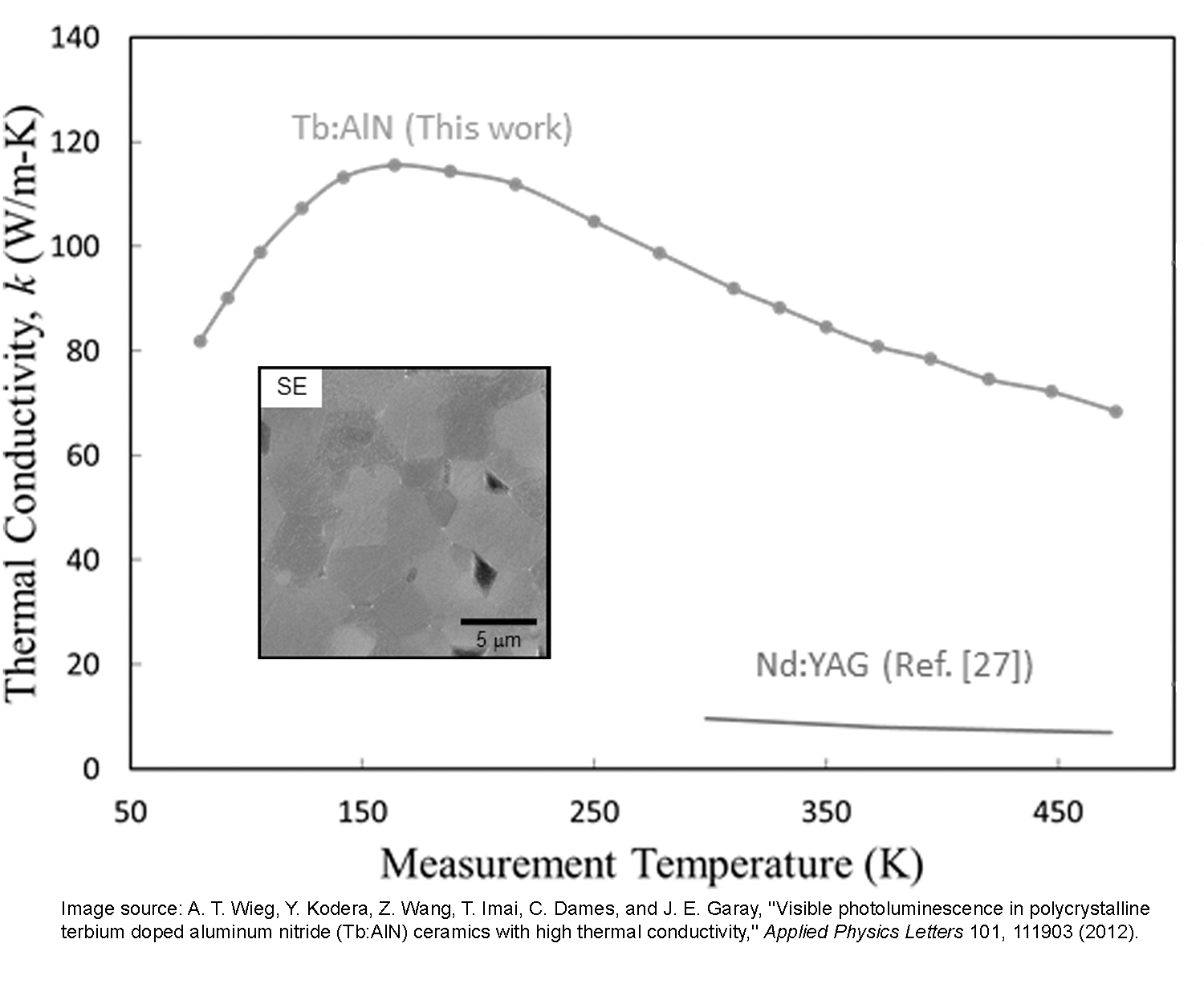
The ultimate power limit of high power lasers scales directly with the thermal conductivity of the lasing media, due to issues of thermal lensing and/or thermal stresses. As shown in the Figure, the traditional lasing material Nd:YAG has a thermal conductivity of around 14 W/m-K at room temperature. In contrast, we have recently measured the thermal conductivity of aluminium nitride doped with rare earth ions (RE:AlN) as 94 W/m-K. Thus, if RE:AlN can also be shown to lase efficiently it would be a very promising material for higher power lasers. In this project the optical and thermal performance of RE:AlN will be simultaneously optimized by the use of a highly anisotropic microstructure. We will measure the aniostropic thermal conductivity of these materials, and develop models for the effects of anisotropic grain boundary scattering on the phonon thermal conductivity. In addition, the material’s expected thermal and mechanical performance in a laser application will be predicted using finite element method (FEM) simulations. This research is in collaboration with the groups of Prof. J. Garay (synthesis and lead) from UC San Diego and Prof. E. Haberer (optical performance) from UC Riverside.
Publications: Wieg et al.; Mishra et al.; Wieg et al.
Nanoparticle Luminescence Thermometry

Nanoparticle luminescence thermometry is a far-field, non-contact thermometry technique that enables single point temperature measurements with high spatial resolution. We excite individual nanoparticles with a laser that is still diffraction limited, but ensure that only one nanoparticle is within the laser spot. Thus all emission comes from that single particle, and the spatial resolution of the temperature measurement is determined by the nanoparticle size rather than the laser beam diameter. We have demonstrated the first temperature measurements using sub-50 nm individual upconverting nanoparticles. This technnique can be used to probe thermal transport in nanostructures, microelectronics, plasmonic devices, and living cells. This work is done in collaboration with The Molecular Foundry at Lawrence Berkeley National Laboratory and is supported by an NSF GOALI grant in partnernship with Seagate.
Publications: Kilbane et al.; Pickel et al.
Transient Electrothermal Phase Front Tracking
Our lab is working on developing nondestructive detection for buried features, such as defects or phase change boundaries. For this, we use the electrothermal “3 Omega” technique, traditionally used to measure thermal conductivities of solids. Using this technique to probe multiple heating frequencies continuously allows for the location of phase change boundaries to be tracked in real time. The figures above shows an example of a moving ice/water freezing front, and 3 Omega voltage changes corresponding to a freezing and thawing event. Applications for this work include cryosurgery and cryopreservation, where this technique can be applied to prevent damage to healthy tissue as well as allowing the freezing and thawing processes to be better understood. This research is being done in collaboration with Prof. J. Bischof from University of Minnesota, and currently is supported by X-Therma.
Publications: Hodges et al.; Natesan et al.; Hodges and Dames
Cost Analysis of Thermoelectrics
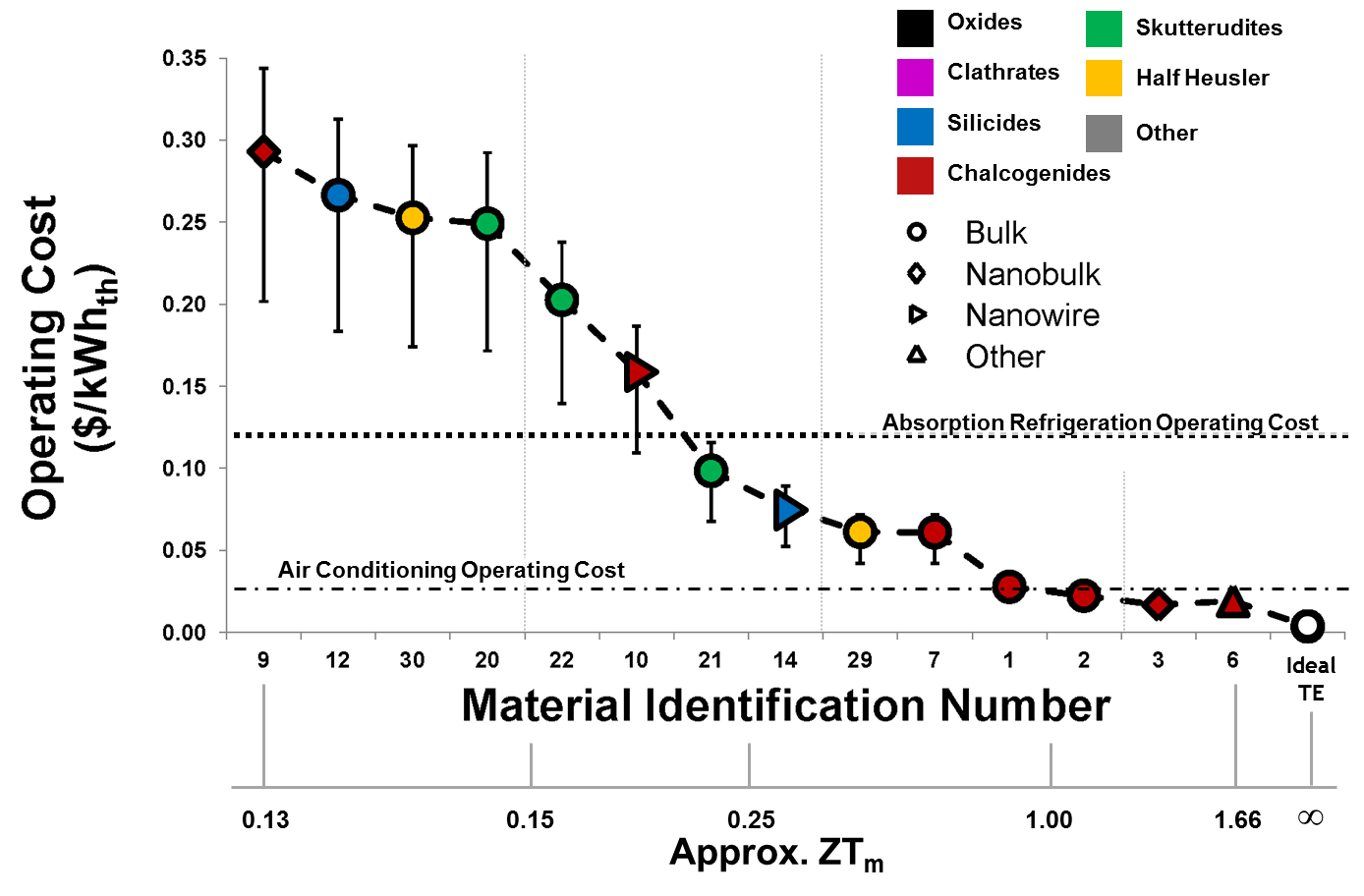
Thermoelectric materials can convert heat directly into electricity with no moving parts, making them appealing for distributed power generation. However, due to issues of cost, manufacturability, abundance, and material performance, the full potential of thermoelectrics has yet to be realized. One potential path towards further improvements is to take advantage of unique transport characteristics at organic-inorganic interfaces in a new class of hybrid thermoelectric materials. Measurements of films of such hybrid materials show some transport properties superior to those of either component (led by the R. Segalman group). Polymer-based materials are also appealing because they may have substantially lower manufacturing costs than traditional solid thermoelectric materials. We are developing new performance metrics for thermoelectric materials that take into account the tradeoffs between raw thermodynamic performance (ZT) and the costs of materials and manufacturing (preliminary results shown in the figure; collaboration with S. LeBlanc and the K. Goodson group at Stanford.)
Publications: Yee et al.; LeBlanc et al.; Dames
Ray Tracing Simulations

The thermal conductivity of nanostructures is size-dependent due to energy carrier mean free path suppression from boundary scattering. We developed a new numerical phonon ray technique to quantify this size effect for structures such as nanograined materials [1] and 3D nanofabricated silicon [2]. By combining ray tracing of silicon nanomeshes with our collaborator’s experimental measurements, we showed that phonon transport in nanomeshes is dominated by the boundary scattering size effect, not by phonon wave interference effects [3].
Publications: Lee, Lee, Wehmeyer et al.; Wei et al.; Hori et al.
Highly Anisotropic Thermal Transport

We model heat conduction in anisotropic materials, such as mica or graphite. Our models showed that typical calculations of the thermal boundary conductance can vastly overestimate the conductance of anisotropic materials [1], and that anisotropic materials can have a minimum thermal conductivity even lower than the “lower-bound” estimate of isotropic models [2]. We used molecular dynamics simulations to show that increasing the bonding strength along one direction surprisingly decreases the thermal conductivity in the orthogonal direction [3], an effect referred to as “phonon focusing”. We also derived a new Onsager reciprocity relation for anisotropic thin films.
Publications: Chen et al.; Chen et al.; Wei et al.
Mean Free Path Spectroscopy
Understanding the thermal conductivity reduction caused by boundary scattering in micro- and nano-structured materials requires a detailed understanding of the intrinsic mean free paths (MFPs) in a bulk sample. The distribution of such MFPs is known as the thermal conductivity distribution function, and its integral as the accumulation function. For example, the calculation depicted in the Figure shows that in bulk Si at 300 K, 50% of the heat is carried by phonons with MFPs longer than 0.53 microns. We are developing an analytical framework to relate a material's bulk MFP spectrum to the thermal conductivity of a corresponding nanostructure. We are also investigating how nanostructuring of bulk materials affects their MFP spectrum.
Publications: Dames & Chen; Yang & Dames; Yang & Dames
Polycrystalline Materials with Anisotropic Grains

Bulk-sized composites made up of self-assembled submicron lamellae such as PbTe/Sb2Te3 have low synthesis costs, and their thermoelectric efficiency benefits from the reduction of thermal conductivity via interfacial scattering. However, modeling the effective macroscopic thermal conductivity of such a nanocomposite is complicated by the fact that the grains have random orientations. We used the frequency-dependent Boltzmann transport equation to evaluate the in-plane and cross-plane thermal conductivities of a single grain. These values were then combined using an analytical averaging rule from the literature that was verified numerically using FEM simulations (Figure). This work was done in collaboration with Dr. Ikeda and Dr. Snyder from the California Institute of Technology.
Publications: Yang et al.
Thermal Properties of Flexible, Printable Nanocarbon Paper

We analyze the thermal properties of a novel nanocarbon paper material synthesized by our collaborators in the Bing Research Group at the University of Maryland. This reduced graphene oxide (RGO)-based paper can sustain extremely high temperatures (up to 3000 K), and also has a number of other interesting properties. When heated to very high temperatures, the RGO paper emits visible light. It is a highly efficient visible light emitter compared to other graphene- or carbon-based lighting materials in part due to its relatively low thermal conductivity. In addition, the RGO paper has a high power factor compared to other carbon nanomaterials, which along with its high operating temperature and comparatively low thermal conductivity make this material attractive for thermoelectric applications. It is also strong and flexible, and arbitrary shapes can be fabricated using a variety of low-cost methods.
Publications: Bao, Pickel et al.; Li, Pickel et al.
Johnson Noise Thermometry
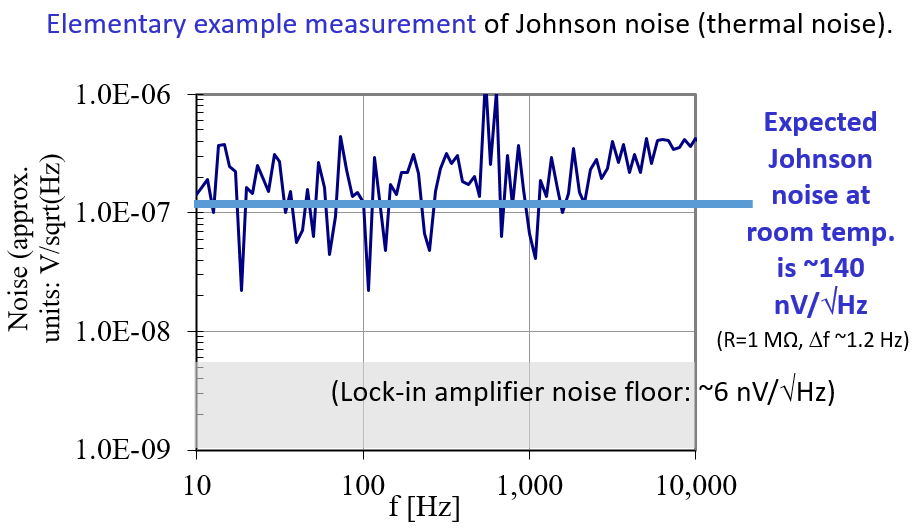
The thermal vibrations of atoms produces a small (1nV–1µV) voltage signal. This voltage noise is proportional to temperature based on fundamental constants alone, and hence requires no calibration or fitting of empirical factors. If the signal can be measured cleanly, this primary thermometer is able to measure low (~1K) and high (~1000K) temperatures and is unaffected by material properties, external radiation, or extreme temperatures and pressures. Digital electronics have made accurate Johnson noise thermometry (JNT) possible and less expensive. After building a prototype, we will design and build a JNT system, verify its accuracy, and use it to measure thermal properties of nanomaterials such as thermal conductivity (k). This tool can also help validate established techniques of measuring thermal properties such as 3-omega and time-domain thermoreflectance.
Graphene Thermal Transport
Understanding the heat transfer in graphene is important for fundamental physics as well as device applications. We are measuring the thermal conductivity and thermal contact resistance of graphene as a function of temperature and the number of layers. For most practical applications, graphene will be supported or encased by another material, and we study this configuration using 3 omega and heat spreader methods (Fig. 1). We are also interested in the intrinsic thermal conductivity of suspended graphene. After cleaning, such samples exhibit a strong Dirac peak in the electrical conductivity (Fig. 2), and we are interested in the possibility of observing an analogous peak in the thermal conductivity. This work is done in collaboration with Prof. C. N. Lau’s group at UC Riverside.
Publications: Jang, et al.; Jang, et al.; Chen et al.
Graphene Thermo-Mechanics
We are also interested in graphene's thermo-mechanical properties, such as its negative coefficient of thermal expansion (CTE). We created a home-built heating stage to monitor graphene's morphology inside an SEM. Using this setup, we can create and monitor ripples which arise due to the thermal expansion mismatch between substrate and the suspended graphene (Fig. 1). We are continuing to investigate ripple phenomena using electrostatic and thermal control techniques. In many cases the ripple patterns can be largely understood using theories of continuum elasticity. This work is done in collaboration with Wenzhong Bao and Prof. C. N. Lau from UC Riverside, and Prof. S. B. Cronin from the University of Southern California.
Publications: Bao et al.; Chen et al.; Bao et al.
Phonon Wavepackets in Graphene

Graphene nanoribbons (GNRs) with zigzag boundaries have been reported to have higher thermal conductivities than those with armchair boundaries, though the detailed mechanism underlying this chirality dependence is under debate. We used classical phonon wave packet (WP) dynamics simulations to study the scattering of acoustic phonons at the zigzag and armchair edges of suspended GNRs. The most remarkable observation is that zigzag boundaries always show 100% forward scattering, while armchair boundaries show significant angle-dependent backscattering, which must also lower the thermal conductivity. The figure shows representative simulation results for a ZA phonon incident on a zigzag (a) and armchair (b) edge. This work was done in collaboration with Prof. Yunfei Chen’s group from Southeast University in China.
Publications: Wei et al.
Mercury Pollution Dectection

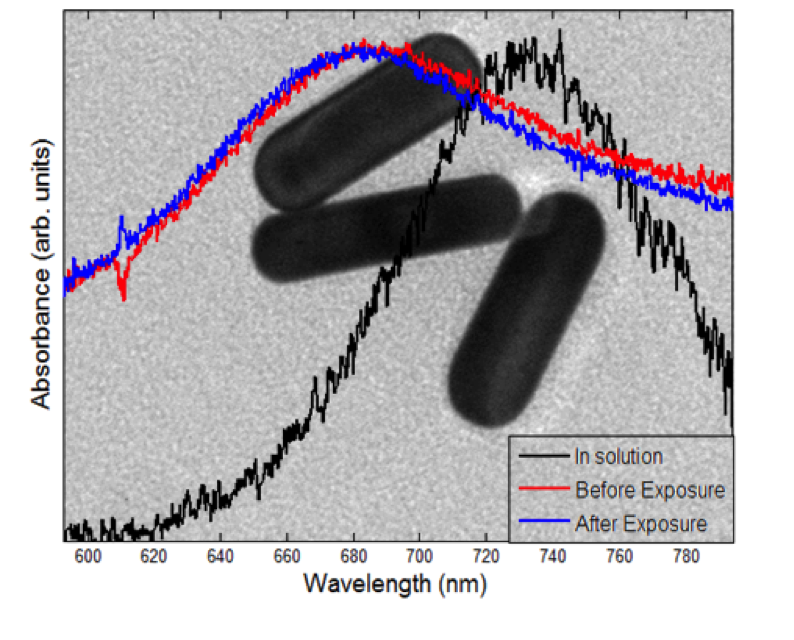
Mercury is a well-known neurotoxin of particular concern to infants and the fetuses carried by pregnant mothers; around fifty percent of the anthropogenic mercury released comes from coal fired power plants. This project aims to develop an affordable yet effective mercury sensor to aid in the detection and control of mercury emissions from power plants, though it may be extended to mercury detection for other applications. It takes advantages of the tunable and sensitive optical properties of gold nanoparticles and the established affinity between gold and mercury, which readily form an amalgam. In addition to practical concerns in developing the sensor, the project aims to understand some of the fundamental science behind its operation, such as the mass transfer characteristics and the thermodynamics of mercury adsorption onto gold nanoparticles. The project is led and co-directed by Dr. Catherine Koshland from the department of Public Health, and Dr. Donald Lucas from the Environmental Energy Technologies Division at Lawrence Berkeley National Lab.
Past and Present Funding Sources
 | NSF |
|
| DARPA |
|
|
 | ARO | |
 | DOE |
|
| ONR |
|
|
 | AFOSR | |
| Molecular Foundry at LBNL |
We benefit significantly from the Molecular Foundry User Program at Lawrence Berkeley National Laboratory. A number of our current and past research projects (listed below) have predominantly been carried out using Foundry facilities, and we maintain ongoing collaborations with a number of staff scientists:
|
|
| Hertz Foundation |
|
|
 | UC Berkeley |
|
| Western Digital |
|
|
| Toyota |
|


